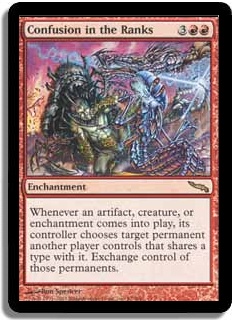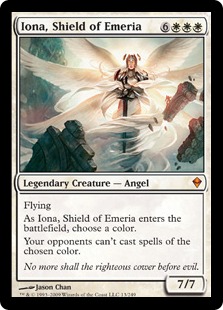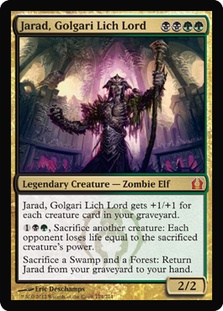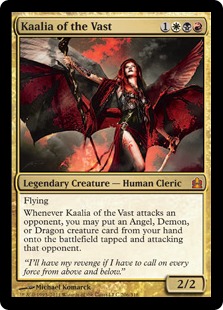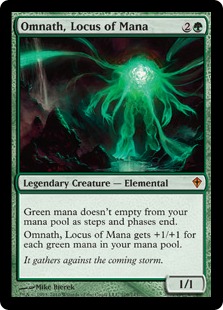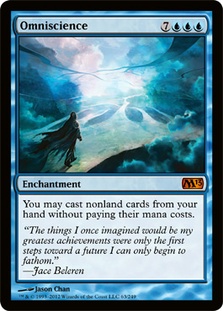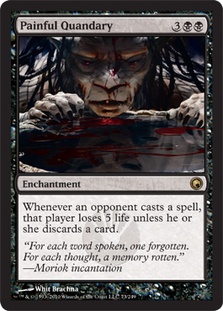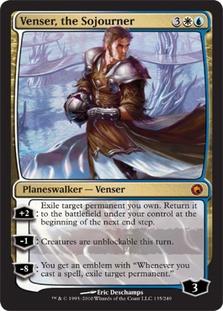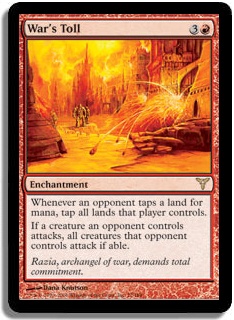I’ve written three separate times about cards that you can’t get angry about when someone blows up, exiles, or counters them (here, here, and here). They’re really powerful cards that you might have fun with but are so strong or demonstrate that you’re up to no good to the point that it’s reasonable for everyone playing with you to want to get rid of them. You cast them and hope no one notices or has an immediate answer.
We’re not talking about cards that need to be banned or necessarily create miserable game states (although there are a few of the latter)—we’re not even talking about cards that are one shot game-winners—we’re talking about cards that give you a strong upper hand in the game, usually irrespective of context. They’re also not necessarily that widely played, although again, they certainly are in some cases. I’m not suggesting that you stop playing any of these cards, either. I’m just suggesting that you shrug and say “fair” when someone kills them. You know you had shenanigans in mind.
Alchemist’s Refuge, Leyline of Anticipation, Vedalken Orrery: Being able to play things at times you normally couldn’t do so provides you with a huge intel advantage. Normally, you have to consider what’s going to happen on everyone else’s turn and delve into a risk assessment. With these, you’re able to do whatever you want except drop land whenever you want. Obviously, combining these with Seedborn Muse makes you the archenemy.
Aura Shards: This is one that I got from crowd sourcing, and I have to say it initially surprised me because it was way off my radar as a must nuke now. Enough people mentioned it that I thought it was worth including. My initial thought was that someone having it out keeps artifact and enchantment strategies in check. Thinking more about it, it keeps people from playing them at all, so I completely get it.
Blind Obedience, Kismet, Loxodon Gatekeeper: You don’t mind as much when your creatures come in tapped because you weren’t going to attack with them anyway. Everything else coming in tapped really puts a crimp in your style. The additional incremental advantage of extort pushes Blind Obedience right over the top, especially in a multiplayer game where you get three times the benefit.
Bloodchief Ascension: It seems so innocuous at first (“it’s just two at a time”), but then you’re losing life when you crack a Terramorphic Expanse or Sakura-Tribe Elder. That’s followed up with losing a pile when someone Wraths, and suddenly the guy playing it is at 100. It’s sneaky because it’s passive. All you have to do after it comes online is have the game play out normally.
Birthing Pod: If you Pod away something and don’t know what you’re getting, you deserve to have something else blown up too. I don’t have any issues with “I wonder if there are any nine-drops in here?” but when you Pod away your Wood Elves, just get your Solemn Simulacrum and search for your land while you’re in there.
Cloudstone Curio: This can be a very interesting card that you use to get a lot of mileage out of your enters-the-battlefield trigger creatures. You can use creatures with flash or token creators to save your guys from targeted removal. It can be quite full of jackanapery, like with two morphs and Animar (a charge I will plead guilty to).
Confusion in the Ranks: I like to embrace as much chaos as the next guy, but I really understand how this can get under someone’s skin. It’s particularly (and intentionally) irritating with Norin the Wary. Maybe the two of them together will inspire a future card called Annoyance in the Ranks.
Dream Halls: Because it’s an ancient card with a narrow purpose, we don’t see much of it. That doesn’t make it any less scary. It’s like anything else that changes the fundamental nature of how the game works: it lends itself to being broken. I always thought that it’d be interesting to use as a way to fuel Reanimation strategies—pitch fatty (probably with blue in it) to draw cards, draw into Reanimate or Zombify or Rise from the Grave, pitch another giant monster to cast it, and so forth. Then there’s madness cards to use with it. That gets me thinking about trying to build around it for fair use—but I still won’t get mad when someone gets rid of it.
Edric, Spymaster of Trest: I’m not a fan of my opponents drawing extra cards. I’ve been known to blow up group hug cards like Howling Mine and Font of Mythos because I think they’re worse for me. Edric, Spymaster of Trest helps my opponents draw lots of cards and gives them an incentive to attack me. I’m knifing that guy first chance I get.
Grip of Chaos: The first time you have to roll a d100 to determine a target is amusing, but it’s a joke that gets less funny each time you tell it. You just wish they’d get to the punch line so you can get on with your day.
Hermit Druid: I personally play this fairly in my Karador deck, with now eighteen basic lands. It’s still really strong for helping me make my land drops and putting stuff in my graveyard. It’s really synergy defined. That said, I know that there are folks who are playing it in turn 3 kill combo decks, so I get it when someone wants it gone. If I sit down with a group that doesn’t know my deck and cast Hermit Druid on turn 2, I will not say a word when they orc-pile it.
Humility: Commander has a strong creature bias, so it’s understandable when people get chuffed if you take away their creatures’ abilities and make their battlecruisers into dinghies. Additionally, there are cases where Humility gets timestamps involved, and everyone hates timestamps. Note that creatures with +1/+1 counters on them will be larger than the others because counters are applied after abilities that set power and toughness to specific numbers.
Iona, Shield of Emeria: You might consider killing Iona just for helping put Painter’s Servant on the banned list (although she’s not the only reason). You really can’t get upset when someone gets rid of a card that’s at least partially locking them out of the game. Strangely enough, I’m of two minds when it comes to Iona and mono-color decks. You get so much advantage by not having to worry about color fixing that there should be some potential downside. Getting completely locked out might be a little extreme, though.
Jarad, Golgari Lich Lord: Jarad can be a seriously quick game-ender combined with cards like Lord of Extinction since your only defense is a ridiculously high life total. The bad news is that once he’s on the battlefield, he’s already active and therefore really dangerous, so killing him might not actually help. If someone casts Praetor’s Grasp on you and takes Jarad just so that you can’t cast him, don’t be mad, bro.
Kaalia of the Vast: A common “Can’t Get Angry” list theme involves cards that give you a great deal for no investment beyond what they originally cost you. If Kaalia helped you cheat out Goblins, Merfolk, and Soldiers, it probably wouldn’t be on this list. Since it can get onto the battlefield for free (and mostly uncounterable, btw) more than one card on this list, you can’t blame people for wishing her a swift and violent end.
Linvala, Keeper of Silence: I like this card a great deal, and I have no qualms when someone frags it. I think it’s a “reasonable protection” card, but since it shuts down a lot of strategies, it’s also eminently reasonable for it to get got.
Luminarch Ascension: Especially when cast early, this gets turned on rather easily. Sure, it costs mana to activate, but the Angels stay around. It’s one of those slow advantage cards that eventually turns the corner from trickle to flood.
Mycosynth Lattice: Either Forge[/author]“]Darksteel [author name="Forge"]Forge[/author] plus Nevinyrral’s Disk or March of the Machines isn’t far behind. Neither of those is good for the rest of us. The Lattice is a card that suggests some interesting ideas (I’d call combining it with Guardian Beast pretty cool), but it always ends up succumbing to the dark side.
Necropotence: The thing likely keeping Necropotence off the banned list is the fact that you don’t get the cards right away (unlike Yawgmoth’s Bargain and Griselbrand). Even so, trading a life for a card was pretty sweet in a format where you started with twenty life. Imagine now what you can do with 40. I’m a little surprised the card doesn’t see more play. I think it can be used judiciously, simply giving you the ability to add a few cards to your hand every now and again. I’m trying a copy in my Obzedat deck because the deck is not so good at drawing cards, but it’s fairly decent at gaining life. We’ll see how it works out.
Omnath, Locus of Mana: Another card that radically changes the way the game works for you, Omnath is frightening, even just as one of 99. Just his ability to store mana would probably merit consideration to play it. The fact that he gets bigger and bigger as you do means you can one-shot someone pretty easily, and no one wants to be on the receiving end of that.
My favorite Omanth story involves one of the first times I played with now good friend Apple. He was playing Omnath as his commander, and it was up in the 50/50 range. He was going to pass his attack step because he didn’t want to be that guy. I suggested he attack me. When he balked, I told him, “You ain’t got the grapes,” so he called my bluff. Except it wasn’t a bluff—I cast Mirror Strike. He unfortunately didn’t have anything to sink that mana into. He’s been gun-shy about attacking me in the two years since, at least when I have 3W open.
Omniscience: “I don’t have any draw spells in my hand. It’s perfectly safe.” LIAR!
Painful Quandary: There might not be a more appropriately named card in the game. There have been a few times when I’ve been on the receiving end of it and was happy to pitch stuff into the yard so that I could Reanimate it later. There have also been a few times when my life total was high enough that it didn’t matter. Mostly, it’s a complete pain.
Price of Glory: I think it’s fine for me to want to punish you for playing a particular style of game (“counter this, counter that, flash in everything”). I also think it’s fine for you to try to wreck me for doing so.
Prince of Thralls: I’ve been playing this on and off in my Thraximundar deck for a long time. It tends to not last, but when it does, it can be really crazy. People rightly fear it staying around and then a Wrath happening. The same goes for It That Betrays, although the conditions are a bit narrower—but it’s an Eldrazi, so it has a different kind of scary.
Riku of Two Reflections: I know Riku is a popular commander. The reason he’s popular is that he helps you do broken stuff. If I were to make a “Top 10 commanders to kill on sight,” list, he’d be on it for sure. Speaking of which, I need to build a new Riku deck…
Shared Fate: Once again, we’re taking the game away from the other players. I like the idea of Shared Fate in theory, but it interacts somewhat poorly with the format because of the restriction on mana production (and no, this isn’t a good enough reason to change that rule). It’d be cool if it were an artifact that let you cast stuff with colorless or any color mana. Then it would be something just wonky enough to be fun without the ability to lock players out.
Sneak Attack: Another card that circumvents the way the game normally gets played. When you can cast and attack with huge guys for one red each, people get justifiably scared. I’ve been really happy with this in Thraximundar, making use of the sacrifice clause, especially with creatures I was going to evoke anyway. Remember that during EOT of the player to your right, you can Sneak stuff in and have it available during your own turn. Sneak Attack combos extremely well with another card on this list: Deadeye Navigator. For the low cost of 1UR, you can get your favorite fatty into play for good, assuming DEN isn’t already soulbonded.
Static Orb: This is one I hadn’t thought of until someone brought it up online. I’ve already beaten the horse about taxation strategies, so no need to pile on.
Talrand, Sky Summoner: I’ll add this one with a “if it’s the commander” caveat. As one of 99, it’s probably fine. As a commander, I’m sure your intentions are not honorable.
Venser, the Sojourner: Venser the planeswalker can come at you two different ways. The absurdity of the ultimate is one thing, but it’s the unblockable ability that scares me most.
War’s Toll: I play this in Ruhan, and I’m really surprised at how long it tends to last. Most of the time, people let it go for a while and then realize that it doesn’t affect me. I will run this out as quickly as I can so that it eats enchantment removal and I have a better chance of keeping Repercussion (which could easily find itself on the list as well) in play.
Warstorm Surge: Hey, if you had been friendly and cast Pandemonium instead, it might have been okay, but you had to get greedy and just keep it all for yourself. Jerk.
Thanks to the folks over at the official forums and MTG Salvation for the ideas and comments on this list. You can check out threads on both sites for more discussion on the topic. Once again, this isn’t a list of cards I’m suggesting that you don’t play. It’s a list of cards that you should celebrate when you have working because they’re fun and powerful. There’s just no need to get wrapped around the axle when someone gets rid of them. You have that Regrowth ready anyway, right?


